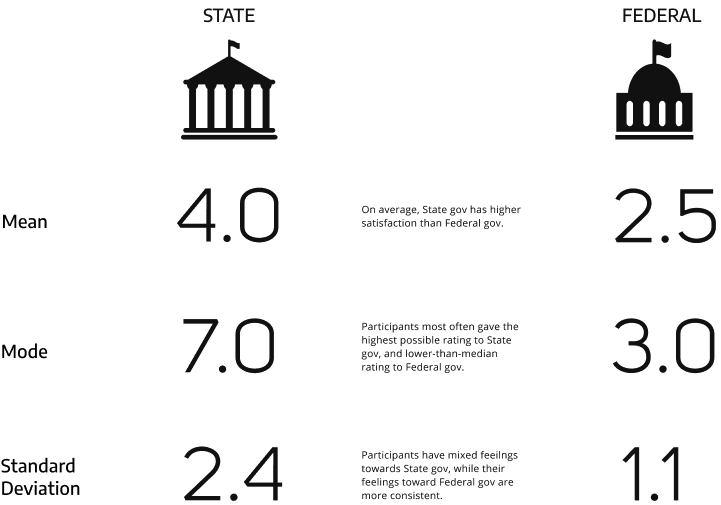Government & COVID-19
A mixed-methods study on peoples' attitudes regarding the Government's response to COVID-19
Summary
PROBLEM
During the immediate turmoil of the COVID-19 pandemic, it was unclear how people in the greater Seattle area thought and felt about how the state, local and national Governments were responding to it.
RESULTS
People’s thoughts and feelings largely depended on the level of Government, policy communication style, and how they consumed their information.
TEAMMATES
Rajiv Pennathur, Clara Wang, and Erika Johnson
MY RESPONSIBILITIES
- Scoped and designed study
- Created and deployed survey screener
- Developed and deployed consent form.
- Identified and implemented three research methods
- Analyzed quantitative and qualitative data
- Presented to stakeholders
Background
PROBLEM SPACE
In April 2020, in response to the COVID-19 pandemic, both local and national Governments rolled out policies that profoundly impacted people in the greater Seattle area. Rather than relying on the media’s portrayal of people’s reaction to governmental response, it is important to investigate how people truly think and feel about this response. Doing so would be a first step to implementing changes and adjusting policy in a way that represents the local constituents.
APPROACH
To address this issue, we designed and implemented an exploratory research study using sequential and concurrent data collection methods as well as convergent data analysis. Participants were asked to do a diary study and photo journal concurrently over a period of two weeks before concluding with a 30-minute interview.
Methods
RECRUITMENT & SCREENING
We recruited Seattle area locals by posting on social media and by word of mouth. Participants were given a link to a Google Form Screener to ensure they qualified for the study. Although we received significant interest for the study up front (n = 101), only 38 people opted to be contacted and 11 were willing to commit to a two week study.
DIARY STUDY
Each diary entry consisted of quantitative and qualitative data collected via 9-item survey which was filled out every time participants experienced a COVID-19 related event such as wearing a mask or receiving stimulus check.
Quantitative Items
- How long ago did this happen? (six-item multiple choice)
- How much of a disruption was this situation to your normal life? (7-point likert)
- How would you rate your overall attitude toward the local/state government? (7-point likert)
- How would you rate your overall attitude toward the US government?
- Please rate your satisfaction of how well the local/state government is handling the Covid crisis (eg, policy, restrictions, communication with public).
- Please rate your satisfaction of how well the US government is handling the Covid crisis (eg, policy, restrictions, communication with public).
Qualitative Data
- Please describe the event that prompted this entry.
- What kinds of emotions were you experiencing while that event was happening?
- What kinds of emotions are you experiencing right now?
PHOTO JOURNAL
The photo journal was comprised of daily image submissions which visually depicted the participants’ attitudes toward the government.
INTERVIEW
Interviews were semi-structured and largely drew from participants submissions. Participants were asked about notable entries and Participants were given an interactive task wherein they came up with next year’s newspaper headline.
Analysis
Quantitative data were examined using descriptive and inferential statistical methods. Qualitative data from diary studies, photo journals, ands interviews were analyzed using affinity mapping to identify key themes that were consistent among participants. Both quantitative and qualitative data were then converged to provide richer context behind findings.
Findings
QUANTITATIVE
Considerable differences were observed between satisfaction and attitude toward state/local vs federal governments.

QUALITATIVE
Our primary findings suggest that, on balance, people had a negative opinion about the national response to COVID-19 while maintaining a positive view of the state/local response.

Next Steps
- Governments should substantiate plan with data and communicate it clearly and confidently to constituents
- In a crisis, government plans should highlight near-term solutions to reassure constituents.